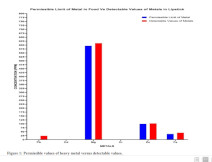Evaluation of cosmetic lipsticks for hazardous heavy metals and determination of antimicrobial potency
https://doi.org/10.51412/psnnjp.2022.29
Keywords:
antimicrobial potency, hazardous heavy metals, Cosmetic lipsticksAbstract
Background: Lipstick, a cosmetic product containing pigment, wax materials, oils and emollient that apply color, is the most widely used cosmetic make-up to enhance the beauty of lips. Consciously or unconsciously, lipsticks have cast a spell over cultures for years and its possible health implications on the consistent wearer's remain a subject of controversy. This study evaluated commercial lipsticks purchased from selected beauticians' shops in Ibadan for antimicrobial potency and hazardous heavy
metals.
Methods: One gram (1g) of representative lipsticks samples was weighed on analytical weighing balance and dissolve in 10 mL of acetone. A stock concentration of 100mg/mL was prepared using 50% acetone as diluents. Thereafter, 5mL of the stock was pipette in to 5mls of 5% acetone to make a concentration of 50mg/mL . A quantity of 0.8g of each representative samples were weighed and 8mL of HNO3: HCl (1:3) were added to the samples in each beaker. The samples were heated and the preparation was allowed to cool and filtered to removed undissolved waxy materials, while the digested solutions were made up to mark 40 ml with sterile distilled water. The sample solutions were analyzed for Cr, Pb, Cd, Mn, Fe and Zn using FlameAtomicAbsorption Spectrophotometer. Culture of E. coli, S. aureus, K. pneumonia, Streptococcus sp, and Pseudomonas aeruginosa seeded in molten
Mueller Hinton agar were challenged with (100mg/mL and 50mg/mL) concentrations of selected acetone dissolved lipsticks samples using agar well diffusion technique.
Results: Lead was found in varied concentrations in all the 15 samples examined, while Cadmium, Magnesium, Zinc and Iron were found in 7 of the 15 samples, Chromium was found in 3 of the total samples examined. Thirteen (13) of the 15 samples of lipsticks examined exhibited antimicrobial property against Escherichia coli, Staphylococcus aureus and Klebsiella spp at either 100 mg/mL
and/or 50mg/mL.
Conclusion: The degree of heavy metals detected from the samples examined could be inimical to user's health coupled with the susceptibility of some of the lipsticks sample to bacteria of clinical potential. There is therefore a need for extensive testing to assess and assure the efficacy of lipsticks regularly before delivery to markets.
References
Maru, AD., Lahoti, SR (2018). Formulation and evaluation of lipstick containing sunflower wax. Int. J. Pharm. Res. 10:126–130.
Nkansah, MA, .Owusu –Afryie E. and Opoku, F.(2018) Determination of Pb and Cd contents in lipstick and their potential health risks to
consumers Journal of Consumer Protection and food Safety. 73:191-198.
Bijauliya, RK., Alok, S., Kumar, M., Chanchal, DK. and Yadav, SA(2017) comprehensive review on herbal cosmetics. Int. J. Pharm. Sci. Res. 8, 4930–4949.
Zakaria, A and Ho,YB.(2015) Heavy metal contamination in lipsticks and their associated health risks to lipstick consumers. Regulatory
Toxicology and Pharmacology. 73:191-195.
Suleiman VA and Labaran AM (2017). Spectroscopic determination of some heavy metals present in various types of lipstick sold
with Bauchi metropolis. International Journal of Science and Engineering Research.8 (8):175-184.
Iwegbue,CMA, Bassey,FI, Obid, G, Tesi, GO and Martincigh BS.(2016) Concentrations and exposure risks of some metals in facial cosmetics in Nigeria. Toxicol Rep. 3: 464-472
United States Environmental Protection Agency (2011). Integrated risk information system. Environmental Protection Agency region 1.
USEPA, Washington D.C:191-195.
Łodyga-Chruścińska, E., Sykuła, A., Więdłocha, M (2018). Hidden metals in several brands of lipstick and face powder present on polish market. Cosmetics. 5: 57
.Chruscinska,EL, Sukula A and M.Wiedlocha (2018) Hidden metals in several brands of lipstick and face powder present in Polish market,.
Cosmetics 57: 1-8.
Sani, A., Gaya, MB. and Abubakar, FA (2016) Determination of some heavy metals in selected cosmetic products sold in kano metropolis, Nigeria. Toxicology Reports. 3:866-869 http://dx.doi.org/10.1016/j.toxrep.2016.11.001
Sehecie, B and IV. Dragojevic (2005). Biscuits as source of calcium, magnesium, sodium and potassium in nutrition. Deutsch. Lebensmittel. Rundsch., (101):392-397
Choi, YY. (2011). International/National Standards for Heavy Metals in food. Chemist. Government Laboratory. Retrieved August 27,
https://www.govtlab.gov.hk/g/texchange/Stds%2 0for%20heavy%20.
U.S. FDA (U.S. Food and Drug Administration). (2005). Guidance for industry lead in candy likely to be consumed frequently by small children: Recommended maximum level and Enforcement policy.
Kadu M, Vishwasra S, Singh S. (2015) Review on Natural Lip Balm. Int J Res Cosmet Sci. 5(1): 1-7.
Harshad SD, Wankhade AB. (2019) Design and characterization of Nutraceutical lipstick of Beetroot Powder. Innovative International Journal of Medical and Pharmaceuticals Sciences 4(2): 1- 4.
Chaudhari NP, Chaudhari NU.Areview on Herbal lipstick from different natural coloring pigments. Indian J Drug, 2018; 6(3): 174-179.
Panda, S.(2018) Preparation and evaluation ofHerbal Lipstick. J Pharm Adv Res,. 1(2): 117-119.
Rigano, L. and Montoli, M(2021). Strategy forthe development of a new lipstick formula.Cosmetics 8:105.
Afandi,A.S.R.U.L, Lazim,AM.,Azwanida, NN.,Bakar, MA., Airianah, OB., Fazry, S.(2017). Antibacterial properties of crude aqueous
Hylocereus polyrhizus peel extracts in lipstick formulation against gram-positive and negative bacteria. Malaysian Appl. Biol. (46):29–34
Lwin, T., Wai, K.Z., Lwin, CC. and Chit, K. (2018) Determination of Lead Content in Red Colored Lipsticks from Mandalay Market by
Flame Atomic Absorption Spectrophotometer. Myanmar Health Sciences Research Journal, 30:167-173. http://www.myanmarhsrj.com
https://doi.org/10.34299/mhsrj.30.03.0045
Ministry of Food and Drug Safety, Regulations on the Safety Standards, etc. of Cosmetics (available at,https://chemicalwatch.com/asiahub/54695/regulation-on-safety-standards-etc-of-cosmetics) (2017).
Neza, E. and Centini, M.(2016) Microbiologically contaminated and over-preserved cosmetic products according Rapex 2008–2014 study. Cosmetics 3(1):3
Babalola, M O. and Eze, M . (2015) Microbiological Quality and Characterization of Potential Pathogens Associated with Selected Brands of Commercial Cosmetic Products in Nigeria. Br. Microbiol. Res. J. 9(5):1–17.
Stewart, S., Parker, M., Amézquita, A. and Pitt, T(2016). Microbiological risk assessment for personal care products. Int. J. Cosmetic Sci. 38(6): 634–645
Dadashi, L. and Dehghanzadeh, R(2016). Investigating incidence of bacterial and fungal contamination in shared cosmetic kits available in the women beauty salons. Health Promot.Perspect. 6(3):159.
SGS (2017). Importance of microbiological quality to cosmetics (available at,https://www.sgsgroup.com.hk/en/news/2017/02/i mportance-of-microbiological-quality-tocosmetics).
Muhammed, H. J.(2017) Bacterial and fungalcontamination in three brands of cosmetic marketed in Iraq. Iraqi J. Pharm. Sci. 20(1):38–42

Published
How to Cite
Issue
Section
License

This work is licensed under a Creative Commons Attribution-NonCommercial 4.0 International License.

